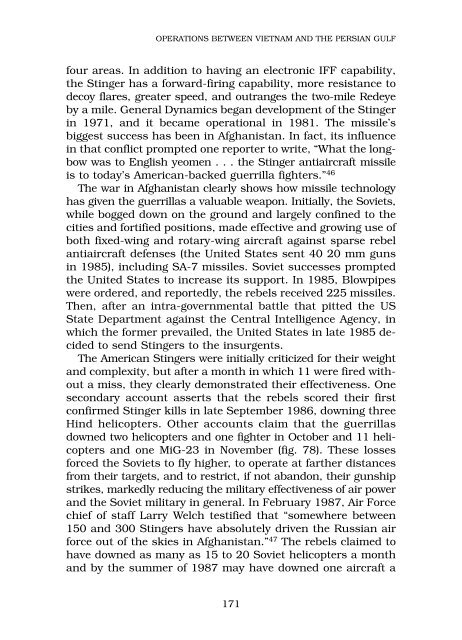Archie to SAM: A Short Operational History of Ground-Based Air ...
Archie to SAM: A Short Operational History of Ground-Based Air ...
Archie to SAM: A Short Operational History of Ground-Based Air ...
You also want an ePaper? Increase the reach of your titles
YUMPU automatically turns print PDFs into web optimized ePapers that Google loves.
OPERATIONS BETWEEN VIETNAM AND THE PERSIAN GULF<br />
four areas. In addition <strong>to</strong> having an electronic IFF capability,<br />
the Stinger has a forward-firing capability, more resistance <strong>to</strong><br />
decoy flares, greater speed, and outranges the two-mile Redeye<br />
by a mile. General Dynamics began development <strong>of</strong> the Stinger<br />
in 1971, and it became operational in 1981. The missile’s<br />
biggest success has been in Afghanistan. In fact, its influence<br />
in that conflict prompted one reporter <strong>to</strong> write, “What the longbow<br />
was <strong>to</strong> English yeomen . . . the Stinger antiaircraft missile<br />
is <strong>to</strong> <strong>to</strong>day’s American-backed guerrilla fighters.” 46<br />
The war in Afghanistan clearly shows how missile technology<br />
has given the guerrillas a valuable weapon. Initially, the Soviets,<br />
while bogged down on the ground and largely confined <strong>to</strong> the<br />
cities and fortified positions, made effective and growing use <strong>of</strong><br />
both fixed-wing and rotary-wing aircraft against sparse rebel<br />
antiaircraft defenses (the United States sent 40 20 mm guns<br />
in 1985), including SA-7 missiles. Soviet successes prompted<br />
the United States <strong>to</strong> increase its support. In 1985, Blowpipes<br />
were ordered, and reportedly, the rebels received 225 missiles.<br />
Then, after an intra-governmental battle that pitted the US<br />
State Department against the Central Intelligence Agency, in<br />
which the former prevailed, the United States in late 1985 decided<br />
<strong>to</strong> send Stingers <strong>to</strong> the insurgents.<br />
The American Stingers were initially criticized for their weight<br />
and complexity, but after a month in which 11 were fired without<br />
a miss, they clearly demonstrated their effectiveness. One<br />
secondary account asserts that the rebels scored their first<br />
confirmed Stinger kills in late September 1986, downing three<br />
Hind helicopters. Other accounts claim that the guerrillas<br />
downed two helicopters and one fighter in Oc<strong>to</strong>ber and 11 helicopters<br />
and one MiG-23 in November (fig. 78). These losses<br />
forced the Soviets <strong>to</strong> fly higher, <strong>to</strong> operate at farther distances<br />
from their targets, and <strong>to</strong> restrict, if not abandon, their gunship<br />
strikes, markedly reducing the military effectiveness <strong>of</strong> air power<br />
and the Soviet military in general. In February 1987, <strong>Air</strong> Force<br />
chief <strong>of</strong> staff Larry Welch testified that “somewhere between<br />
150 and 300 Stingers have absolutely driven the Russian air<br />
force out <strong>of</strong> the skies in Afghanistan.” 47 The rebels claimed <strong>to</strong><br />
have downed as many as 15 <strong>to</strong> 20 Soviet helicopters a month<br />
and by the summer <strong>of</strong> 1987 may have downed one aircraft a<br />
171
















